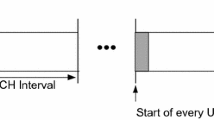Abstract
The mobility of nodes in a vehicular ad hoc network brings about the instability of network topology, which is not beneficial for effective and rapid information transmission. This study proposed a vehicular opportunity routing protocol with area learning (VOAL). Specifically, beacon control was adopted for alleviating the information transmission pressure caused by channel congestion. The statistics of network environment and topology distribution were acquired through beacon exchange, and the hot area was derived based on real-time network information for better information transmission. Finally, the simulations were performed using an open-source simulator opportunistic network environment for comparing VOAL with some classical routing algorithms. The simulation results revealed that VOAL showed enhanced performance.





Similar content being viewed by others
REFERENCES
Chim, T.W., Yiu, S.M., Hui, L.C.K., et al., VSPN: VANET-based secure and privacy-preserving navigation, IEEE Trans. Comput., 2014, vol. 63, no. 2, pp. 510–524.
Dawood, H.S. and Wang, Y., An efficient emergency message broadcasting scheme in vehicular ad hoc networks, Int. J. Distrib. Sensor Networks, 2013, Article 232916. http://dx.doi.org/10.1155/2013/232916
Ghafoor, K.Z., Lloret, J., Bakar, K.A., Sadiq, A.S., and Mussa, S.A.B., Beaconing approaches in vehicular ad hoc networks: A survey, Wireless Pers. Commun., 2013, vol. 73, no. 3, pp. 885–912.
Song, H. and Lee, H.S., A survey on how to solve a decentralized congestion control problem for periodic beacon broadcast in vehicular safety communications, 15th International Conference on Advanced Communication Technology (ICACT), 2013, pp. 649–654.
Sommer, C., Tonguz, O.K., and Dressler, F., Traffic information systems: Efficient message dissemination via adaptive beaconing, IEEE Commun. Mag., 2011, vol. 49, no. 5, pp. 173–179.
Ahmed, S.H., Bouk, S.H., and Kim, D., Adaptive beaconing schemes in VANETs: Hybrid approach, IEEE 2015 International Conference on Information Networking (ICOIN), 2015, pp. 340–345.
Paul, B., Ibrahim, M., Bikas, M., et al., Experimental analysis of AODV & DSR over TCP & CBR connections with varying speed and node density in VANET, arXiv preprint arXiv:1204.1206, 2012.
Paul, B. and Islam, M.J., Survey over VANET routing protocols for vehicle-to-vehicle communication, IOSR J. Comput. Eng., 2012, vol. 7, no. 5, pp. 1–9.
Sommer, C., Tonguz, O.K., and Dressler, F., Adaptive beaconing for delay-sensitive and congestion-aware traffic information systems, IEEE 2010 Vehicular Networking Conference (VNC), 2010, pp. 1–8.
Abumansoor, O. and Boukerche, A., A secure cooperative approach for nonline-of-sight location verification in VANET, IEEE Trans. Veh. Technol., 2012, vol. 61, no. 1, pp. 275–285.
Benslimane, A., Taleb, T., and Sivaraj, R., Dynamic clustering-based adaptive mobile gateway management in integrated VANET–3G Heterogeneous IEEE J. Wireless Networks, Sel. Areas Commun., 2011, vol. 29, no. 3, pp. 559–570.
Chen, R., Jin, W.L., and Regan, A., Broadcasting safety information in vehicular networks: Issues and approaches, IEEE Network, 2010, vol. 24, no. 1, pp. 20–25.
Wu, C., Ohzahata, S., and Kato, T., VANET broadcast protocol based on fuzzy logic and lightweight retransmission mechanism, IEICE Trans. Commun., 2012, vol. 95-b, no. 2, pp. 415–425.
Bitam, S., Mellouk, A., and Zeadally, S., VANET-cloud: A generic cloud computing model for vehicular Ad Hoc networks, IEEE Wireless Commun., 2015, vol. 22, no. 1, pp. 96–102.
Hussain, R. and Oh, H., Cooperation-aware VANET clouds: Providing secure cloud services to vehicular Ad Hoc Networks, J. Inf. Process. Syst., 2014, vol. 10, no. 1, pp. 103–118.
Mukunthan, A., Cooper, C., Safaei, F., et al., Studying the impact of the corner propagation model on VANET routing in urban environments, IEEE Vehicular Technology Conference, 2012, vol. 48, no. 2, pp. 1–5.
Author information
Authors and Affiliations
Corresponding author
Additional information
The article is published in the original.
About this article
Cite this article
Wang, X. A Vehicular Opportunity Routing Protocol with Area Learning: Voal. Aut. Control Comp. Sci. 52, 552–560 (2018). https://doi.org/10.3103/S0146411618060111
Received:
Revised:
Accepted:
Published:
Issue Date:
DOI: https://doi.org/10.3103/S0146411618060111




